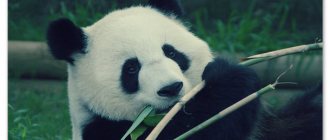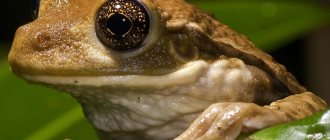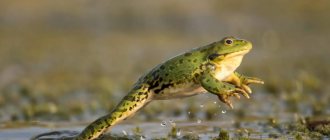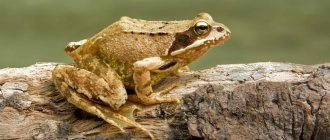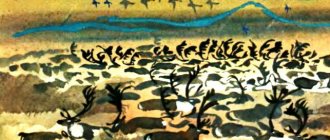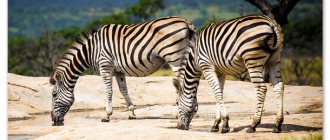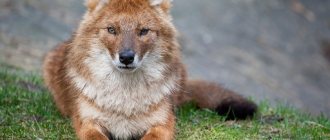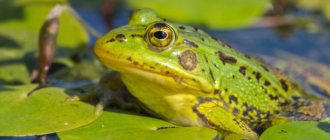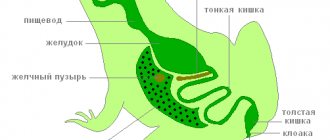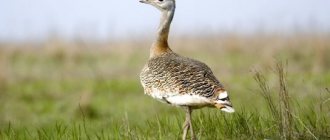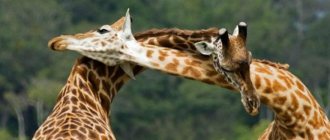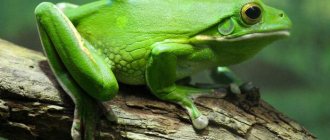Home › Terrariums and inhabitants ›
( 3 ratings, average: 4.67 out of 5)
The red-eyed tree frog (Agalychnis callidryas) is one of the most popular and beautiful pet terrarium frogs. The body of the red-eyed tree frog is light green with blue stripes on the sides, interspersed with white, although the frog can change its color to blend in with its surroundings. Its most noticeable characteristic feature is its bright red eyes, which give the tree frog its name. Sometimes it is also called the red-eyed jumping frog.
These cute red-eyed frogs are not difficult to keep if you follow all the requirements. They are active at night, so they wake up just in the evening when the whole family gathers at home. They are funny, fun to watch, and especially fun to watch as their colors change. Red-eyed tree frogs can change color while hunting, from light green to dark brown, depending on their environment.
The red-eyed tree frog is an excellent pet terrarium frog, suitable for both beginners and experienced breeders. These frogs first appeared in a home terrarium in the mid or late 80s; they were brought from Honduras. It is believed that there are several species of these frogs.
Appearance
It has very modest dimensions, the length of the body is from six to eight centimeters. The head is round. A distinctive feature is large red eyes with vertically located pupils.
Leathery upper eyelids and almost transparent lower ones are necessary for protection: while resting, he observes what is happening around him through the membranes. In case of a possible attack, the tree frog's skin folds drop, its bright red eyes frighten the predator, this makes it possible to escape. Active in the dark.
The tree frog has a scary coloring, but is not poisonous. The skin is smooth. Has a good sense of touch. The size and color depend on temperature, light and other parameters. The body can be either light green or dark. The sides of the tree frog are deep blue, with stripes on them:
- purple
- brown
- yellow
They are directed vertically or diagonally, the number of stripes varies among different populations (from 9 to 5-6). The abdomen is pure white or light cream. Her shoulders and hips are blue or orange. The bright orange toes (and pads too) vary to light yellow.
The paws are equipped with suction cups, which is why it climbs more than it stays in ponds. There may be faint whitish spots or dark green lines on the back. Tree frogs change color from greenish (during the day) to brownish-red (at dusk).
Behavior
Leads a nocturnal lifestyle. Red-eyed tree frogs can swim and have parabolic vision and a good sense of touch. During the day, frogs sleep on the undersides of green leaves, hiding from predators.
During rest, their eyes are covered with a translucent membrane, which does not interfere with the frogs' vision. If a red-eyed tree frog is attacked by a predator, it sharply opens its eyes and their bright red color confuses the attacker. The moment the predator freezes, the frog runs away. When night falls, tree frogs wake up, yawn and stretch.
Despite their bright, frightening color, red-eyed tree frogs are not poisonous, but their skin contains a large amount of active peptides (tachykinin, bradykinin, caerulein and demorphin).
Enemies
The main danger to the tree frog is snakes (parrot, cat-eyed, etc.), as well as lizards, birds, bats and small mammals. Eggs are eaten by monkeys, wasps, reptiles, etc.
They suffer from fungal infections. Fish, arachnids, and arthropods can destroy tadpole fry.
Offspring
The tadpoles hatch almost simultaneously, which allows the liquid released from the eggs to wash them off the leaf into the pond. Sometimes tadpoles fall to the ground. In this case, they can live without water for up to 20 hours. If it rains during this time, the tadpoles will be washed away into a nearby body of water.
In some cases, when something threatens the clutch (for example, an attack by a snake or wasp, possible infection by fungal diseases, flood, etc.), the tadpoles emerge from the eggs ahead of schedule after 4-5 days. Red-eyed tree frog larvae develop external gills, and hatched tadpoles breathe through internal gills and skin. The length of the tadpoles is 4.8 mm. The back color is olive-gray. Complete metamorphosis occurs after 75-80 days.
Reproduction
The tree frog's rainy season is the most suitable weather for the birth of its offspring. Mating occurs intensively in June and October evenings. Males make different sounds: scaring - for competitors and calling - for future partners. Due to the resonator bags, the sound is loud.
The frog begins to croak intensely before sunset, and the sound intensifies with increasing humidity. Female tree frogs spawn on branches hanging above the water surface; there are 35-45 eggs. They are protected by a gelatinous shell, which makes the eggs inconspicuous. By the time they hatch, each one increases in size by one and a half times. Incubation for the green tree frog is one week.
The tadpoles of the red-eyed frog emerge simultaneously and are washed into the pond. The fry grow up to 40 millimeters. After 2 and a half months they turn into frogs.
Feed and feeding
Red-eyed tree frogs are insectivorous frogs, and in captivity will feed on crickets (grasshoppers) and other nutritious insects. Some adult frogs will eat a variety of worms, but most prefer grasshoppers at any age. On sale you can find specialized food for terrarium frogs - canned grasshoppers. These are specially dried grasshoppers that retain all nutrients. But you can also feed them with live food, if possible.
Make sure the food items are the right size for the frogs to eat. An adult tree frog can swallow even the largest cricket, but babies need tiny grasshoppers, no more than 0.5 cm long.
All food products are regularly sprinkled with high quality calcium and vitamin D3. This is especially important for young, growing frogs; they should be supplemented at every feeding. Adult frogs may take this supplement less frequently.
In addition to the calcium supplement mentioned above, reptiles also need a multivitamin. They are given in powder form once or twice a week.
Always read the instructions for use for both calcium and vitamin supplements for proper dosage, as they vary from manufacturer to manufacturer.
Where does it live?
The habitat of this vast family of amphibians is quite significant - and extends to the entire temperate zone of Europe, northern Africa, Australia, both Americas, Asia, China, Japan and many other countries - from Morocco to Egypt and Turkey. In the central part of our country, only two types of tree frogs are common - common and Far Eastern.
These amphibians prefer to live in tropical rainforests, subtropics, broad-leaved and mixed groves, and on the coast of bodies of standing water or in wetlands.
Yellow poison dart frog
The habitat of this amphibian is the tropical rainforests of Colombia, located in its southwest. For rest, the amphibian chooses leaf litter under the dense crowns of trees growing near the reservoir. The terrible leaf climber, as it is also called, is considered the most dangerous vertebrate in the world. The venom of this undoubtedly beautiful tree frog is capable of taking the lives of 10 people at a time. The frog has powerful hind legs. The body is painted yellow-gold with black splashes on the head and body.
Red-eyed tree frog
Red-eyed tree frogs (lat. Agalychnis callidryas) have many advantages. First of all, they are beautiful. A soft green body with blue stripes, bright orange legs, a chicken-yellow belly and expressive red eyes make the red-eyed tree frog one of the most attractive amphibians in the world.
Secondly, they are unpretentious. All they need for a happy life is wet thickets along the banks of rivers and streams in the tropical forests of Central America and the presence of their favorite crickets, which are first on the list of food preferences of red-eyed tree frogs.
However, the matter is not limited to crickets alone, and tree frogs diversify their menu with everything they can swallow - worms, moths, flies and even small frogs.
Thirdly, they are not poisonous, and the only way they can protect themselves is to use their bright colors as camouflage. Here, tree frogs have two options to choose from: hide the bright parts of the body and remain motionless, or, conversely, move as quickly as possible, shimmering in front of the predator’s eyes with all the colors of the rainbow, literally eclipsing his gaze with its beauty.
In the first case, they just need to climb a tree, bend their orange legs and cover the blue stripes on the sides with their legs. In this position, only the upper, green, part of their body remains visible, which completely merges with the lush green foliage of tropical trees.
Their small size (up to 6 centimeters in males and up to 8 centimeters in females) makes them almost invisible to snakes, spiders, bats and birds.
Red-eyed tree frogs can live both near ponds and in trees, but they prefer to lead an arboreal lifestyle, very rarely descending to the ground. The long legs of these frogs are better suited for climbing trees than for swimming, and the suckers on each toe help them move easily along vertical surfaces, including wet leaves and tree trunks. For their ability to make long jumps, red-eyed tree frogs received the name “monkey frogs.”
The red eyes of these nocturnal amphibians have vertical pupils and are equipped with a nictitating membrane that moisturizes them and protects them from dust. Like the body of tree frogs, these membranes are painted in a bright color, but this in no way prevents the frogs from seeing well in the dark. Depending on the mood or environment, red-eyed tree frogs are able to slightly change the intensity of their color.
The mating season for red-eyed tree frogs begins at the height of the rainy season. Sitting on a branch, the male begins to shake it vigorously, making calling sounds. With this behavior he pursues two goals at once - to scare off rivals and attract the attention of his partner.
When the fertilization process begins, the female will carry the male on her back for several hours, then she will pick up a convenient branch with dense foliage hanging over the water and lay eggs.
After a few days, the eggs will develop into tadpoles and fall into the water, where they will spend three weeks to several months until they develop into adult tree frogs and move back to a safe height.
Origin
The red-eyed tree frog is a medium-sized frog, 2.5 - 5 cm. Native to the tropical forests of the extreme south of Mexico and Central America. They are most active at night, when they can be seen and heard. They live exclusively in trees, hiding during the day among dense tropical foliage.
An adult red-eyed tree frog is typically 2.5 - 4 cm in length. Females are almost always larger, both in length and mass, so size can be used to determine the sex of a frog.
It is not known how long these frogs live in nature, but they are very hardy when kept in a home terrarium. Under the right conditions and care, these terrarium tree frogs will delight you for up to 10 years or more. The average lifespan in a terrarium is 10 years.
Medical uses of tree frog venom
Scientists' research into the pharmacological use of frog toxins began back in 1974, when the US National Institutes of Health first conducted experiments with dendrobatid and Epidatidine, the main components of tree frog venom. It turned out that in its pain-relieving properties one substance is 200 times superior to morphine, and the other is 120 times superior to nicotine. In the mid-90s, scientists at Abbott Labs. managed to create a synthetic version of epidatidine - ABT-594, which significantly reduces pain, but does not put people to sleep like opiates. The American Natural History Museum team also analyzed 300 alkaloids found in tree frog venom and determined that some were effective in treating neuralgia and muscle dysfunction.
- The largest frog in the world is the goliath (Conraua goliath) from West Africa, its body length (excluding legs) is about 32-38 cm, weight - almost 3.5 kg. The giant amphibian lives in Cameroon and Guinea, on the sandy banks of the African rivers Sanaga and Benito.
- The smallest frog in the world is the tree toad from Cuba, it grows 1.3 cm in length.
- In total, there are about 6 thousand species of frogs in the world, but every year scientists find more and more new species.
- A toad is the same as a frog, only its skin is dry, unlike frogs, and covered with warts, and its hind legs are shorter.
- The frog sees perfectly at night and is sensitive to even the slightest movement; in addition, the location and shape of the eyes allows it to perfectly view the area not only in front and to the sides of itself, but also partially behind.
- Thanks to their long hind legs, frogs can jump a distance of 20 times their body length. The Costa Rican tree frog has membranes between the toes of its hind and front paws - this unique aerodynamic device helps it float in the air when it jumps from one branch to another.
- Like all amphibians, frogs are cold-blooded - their body temperature changes in direct proportion to environmental parameters. When the air temperature drops to a critical level, they burrow underground and remain in suspended animation until spring. Even if 65% of a tree frog's body is frozen, it will survive by increasing the concentration of glucose in its vital organs. Another example of vitality is demonstrated by the Australian desert frog - it can survive without water for about 7 years.
Content
Terrarium
All standard glass reptile terrariums are ideal for keeping red-eyed tree frogs. Ready-made terrariums for frogs are easy to clean, are available in various sizes, retain heat well and maintain humidity.
The recommended terrarium volume for keeping an adult red-eyed tree frog is 75 liters. In such a terrarium you can keep 3-4 frogs at home. In smaller terrariums, frogs may be injured when they jump and hit the glass.
Smooth clawed frog or aibolit frog
In ordinary aquariums, the smooth clawed frog can be kept along with agile large fish. This is a small - up to 8 cm - creature with a small head, a short blunt muzzle, and eyes turned upward. Near the eyes there is a short tactile filament. The hind limbs are strong, muscular, with dark claws designed for tearing prey. The front paws have long toes without webbed tissue. Along the body there are depressions densely covered with hairs. Frogs of this species are brown or pinkish-orange in color, similar to the skin color of the European.
They live and feed only in water. And their skin secretions purify aquarium water and can even cure fish from infectious diseases. External resemblance to clawed frogs can be seen in African aquatic frogs. But they are thinner, and the muzzle is pointed, and at its end there are nostrils. In addition, this frog is only up to 4 cm in size. Any decorative aquarium with fish is suitable for them, but no more than 40 cm deep. They usually do not leave the water. But it is still worth covering the aquarium so that the frogs do not jump out.
Home call service for a veterinarian
